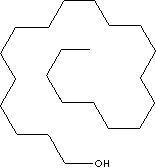| BEHENYL ALCOHOL
|
||||||||||||||||||||||||||||||||||||||||||||||||||||||||||||||||||||||||||||||||||||||||||||||||||||||||||||||||||||||||||||||||||||
|
PRODUCT IDENTIFICATION |
||||||||||||||||||||||||||||||||||||||||||||||||||||||||||||||||||||||||||||||||||||||||||||||||||||||||||||||||||||||||||||||||||||
| CAS NO. | 661-19-8 |
|
||||||||||||||||||||||||||||||||||||||||||||||||||||||||||||||||||||||||||||||||||||||||||||||||||||||||||||||||||||||||||||||||||
| EINECS NO. | 211-546-6 | |||||||||||||||||||||||||||||||||||||||||||||||||||||||||||||||||||||||||||||||||||||||||||||||||||||||||||||||||||||||||||||||||||
| FORMULA | CH3(CH2)20CH2OH | |||||||||||||||||||||||||||||||||||||||||||||||||||||||||||||||||||||||||||||||||||||||||||||||||||||||||||||||||||||||||||||||||||
| MOL WT. | 326.60 | |||||||||||||||||||||||||||||||||||||||||||||||||||||||||||||||||||||||||||||||||||||||||||||||||||||||||||||||||||||||||||||||||||
| H.S. CODE | 2905.29 | |||||||||||||||||||||||||||||||||||||||||||||||||||||||||||||||||||||||||||||||||||||||||||||||||||||||||||||||||||||||||||||||||||
|
TOXICITY |
Oral rat LD50: 12800 mg/kg | |||||||||||||||||||||||||||||||||||||||||||||||||||||||||||||||||||||||||||||||||||||||||||||||||||||||||||||||||||||||||||||||||||
| SYNONYMS | 1-Docosanol; docosan-1-ol; | |||||||||||||||||||||||||||||||||||||||||||||||||||||||||||||||||||||||||||||||||||||||||||||||||||||||||||||||||||||||||||||||||||
| Behenic alcohol; Docosyl alcohol; Docosanol-(1); n-Eicosanol; | ||||||||||||||||||||||||||||||||||||||||||||||||||||||||||||||||||||||||||||||||||||||||||||||||||||||||||||||||||||||||||||||||||||
|
DERIVATION |
|
|||||||||||||||||||||||||||||||||||||||||||||||||||||||||||||||||||||||||||||||||||||||||||||||||||||||||||||||||||||||||||||||||||
|
CLASSIFICATION |
|
|||||||||||||||||||||||||||||||||||||||||||||||||||||||||||||||||||||||||||||||||||||||||||||||||||||||||||||||||||||||||||||||||||
|
PHYSICAL AND CHEMICAL PROPERTIES |
||||||||||||||||||||||||||||||||||||||||||||||||||||||||||||||||||||||||||||||||||||||||||||||||||||||||||||||||||||||||||||||||||||
| PHYSICAL STATE | white solid | |||||||||||||||||||||||||||||||||||||||||||||||||||||||||||||||||||||||||||||||||||||||||||||||||||||||||||||||||||||||||||||||||||
| MELTING POINT | 65 - 73 C | |||||||||||||||||||||||||||||||||||||||||||||||||||||||||||||||||||||||||||||||||||||||||||||||||||||||||||||||||||||||||||||||||||
| BOILING POINT | 180 C at 0.22 mm Hg | |||||||||||||||||||||||||||||||||||||||||||||||||||||||||||||||||||||||||||||||||||||||||||||||||||||||||||||||||||||||||||||||||||
| SPECIFIC GRAVITY | ||||||||||||||||||||||||||||||||||||||||||||||||||||||||||||||||||||||||||||||||||||||||||||||||||||||||||||||||||||||||||||||||||||
| SOLUBILITY IN WATER | Insoluble | |||||||||||||||||||||||||||||||||||||||||||||||||||||||||||||||||||||||||||||||||||||||||||||||||||||||||||||||||||||||||||||||||||
| pH |
|
|||||||||||||||||||||||||||||||||||||||||||||||||||||||||||||||||||||||||||||||||||||||||||||||||||||||||||||||||||||||||||||||||||
| VAPOR DENSITY | ||||||||||||||||||||||||||||||||||||||||||||||||||||||||||||||||||||||||||||||||||||||||||||||||||||||||||||||||||||||||||||||||||||
| AUTOIGNITION |
|
|||||||||||||||||||||||||||||||||||||||||||||||||||||||||||||||||||||||||||||||||||||||||||||||||||||||||||||||||||||||||||||||||||
| NFPA RATINGS | Health: 1; Flammability: 0; Reactivity: 0 | |||||||||||||||||||||||||||||||||||||||||||||||||||||||||||||||||||||||||||||||||||||||||||||||||||||||||||||||||||||||||||||||||||
|
REFRACTIVE INDEX |
||||||||||||||||||||||||||||||||||||||||||||||||||||||||||||||||||||||||||||||||||||||||||||||||||||||||||||||||||||||||||||||||||||
| FLASH POINT |
|
|||||||||||||||||||||||||||||||||||||||||||||||||||||||||||||||||||||||||||||||||||||||||||||||||||||||||||||||||||||||||||||||||||
| STABILITY | Stable under ordinary conditions | |||||||||||||||||||||||||||||||||||||||||||||||||||||||||||||||||||||||||||||||||||||||||||||||||||||||||||||||||||||||||||||||||||
|
GENERAL DESCRIPTION AND APPLICATIONS |
||||||||||||||||||||||||||||||||||||||||||||||||||||||||||||||||||||||||||||||||||||||||||||||||||||||||||||||||||||||||||||||||||||
Fatty alcohols, derived from natural fats and oils, are high molecular straight
chain primary alcohols. They include lauryl (C12), MyrIstyl (C14), Cetyl ( or
palmityl: C16), stearyl (C18), Oleyl (C18, unsaturated), and Linoleyl (C18,
polyunsaturated) alcohols. There are synthetic fatty alcohols equivalent
physically and chemically to natural alcohols obtained from oleochemical sources
such as coconut and palm kernel oil. Fatty alcohols are emulsifiers and
emollients to make skin smoother and prevent moisture loss. Identical fatty
esters are used to improve rub-out of formulas and to control viscosity and
dispersion characteristics in cosmetics, personal care products and
pharmaceutical ingredients. As chemical intermediates, the primary use of fatty
alcohols are as raw material for the production of fatty sulfate salts and
alcohol ethoxylates for foaming and cleaning purposes in the field of detergent
industry. Chemical reactions of primary alcohols include esterifications,
ethoxylation, sulfation, oxidation and many other reactions. Their derivatives
and end use applications include;
Large amount of fatty alcohols are used as special solvents, fillers in plasticizer and insulating materials for the building industry. Fatty alcohols are used as ingredients in the industries of agricultural, foodstuff, metal processing, cosmetics, lube additive, pharmaceutical, rubber, textile, perfume and flavouring as well as synthetic detergent. In pharmaceutical application, behenyl alcohol (a saturated 22-carbon alcohol) exhibits antiviral activity against lipid-enveloped viruses including herpes simplex virus (HSV). Behenyl alcohol is used as an ingredient in the cream for topical treatment of recurrent herpes. It acts by inhibiting fusion between the human plasma cell membrane and the viral envelope. |
||||||||||||||||||||||||||||||||||||||||||||||||||||||||||||||||||||||||||||||||||||||||||||||||||||||||||||||||||||||||||||||||||||
|
SALES SPECIFICATION |
||||||||||||||||||||||||||||||||||||||||||||||||||||||||||||||||||||||||||||||||||||||||||||||||||||||||||||||||||||||||||||||||||||
|
APPEARANCE |
white solid | |||||||||||||||||||||||||||||||||||||||||||||||||||||||||||||||||||||||||||||||||||||||||||||||||||||||||||||||||||||||||||||||||||
|
ASSAY |
78.0 - 85.0% (C22 Alcohol) |
|||||||||||||||||||||||||||||||||||||||||||||||||||||||||||||||||||||||||||||||||||||||||||||||||||||||||||||||||||||||||||||||||||
|
ACID VALUE |
0.2 max ( mg KOH/g) |
|||||||||||||||||||||||||||||||||||||||||||||||||||||||||||||||||||||||||||||||||||||||||||||||||||||||||||||||||||||||||||||||||||
|
IODINE VALUE |
1.0 max ( mg KOH/g) |
|||||||||||||||||||||||||||||||||||||||||||||||||||||||||||||||||||||||||||||||||||||||||||||||||||||||||||||||||||||||||||||||||||
|
SAP VALUE |
1.0 max ( mg KOH/g) |
|||||||||||||||||||||||||||||||||||||||||||||||||||||||||||||||||||||||||||||||||||||||||||||||||||||||||||||||||||||||||||||||||||
| COLOR, APHA | 100 max | |||||||||||||||||||||||||||||||||||||||||||||||||||||||||||||||||||||||||||||||||||||||||||||||||||||||||||||||||||||||||||||||||||
| TRANSPORTATION | ||||||||||||||||||||||||||||||||||||||||||||||||||||||||||||||||||||||||||||||||||||||||||||||||||||||||||||||||||||||||||||||||||||
| PACKING | 25kgs in bag | |||||||||||||||||||||||||||||||||||||||||||||||||||||||||||||||||||||||||||||||||||||||||||||||||||||||||||||||||||||||||||||||||||
| HAZARD CLASS | Not regulated | |||||||||||||||||||||||||||||||||||||||||||||||||||||||||||||||||||||||||||||||||||||||||||||||||||||||||||||||||||||||||||||||||||
| UN NO. | ||||||||||||||||||||||||||||||||||||||||||||||||||||||||||||||||||||||||||||||||||||||||||||||||||||||||||||||||||||||||||||||||||||
| OTHER INFORMATION | ||||||||||||||||||||||||||||||||||||||||||||||||||||||||||||||||||||||||||||||||||||||||||||||||||||||||||||||||||||||||||||||||||||
| European Hazard Symbols: , Risk Phrases: , Safety Phrases: 22-45/46 | ||||||||||||||||||||||||||||||||||||||||||||||||||||||||||||||||||||||||||||||||||||||||||||||||||||||||||||||||||||||||||||||||||||
| GENERAL DESCRIPTION OF FATTY ACID |
||||||||||||||||||||||||||||||||||||||||||||||||||||||||||||||||||||||||||||||||||||||||||||||||||||||||||||||||||||||||||||||||||||
Fatty Acids are aliphatic carboxylic acid with varying hydrocarbon lengths
at one end of the chain joined to terminal carboxyl (-COOH) group at the other
end. The general formula is R-(CH2)n-COOH. Fatty acids are
predominantly unbranched and those with even numbers of carbon atoms between 12
and 22 carbons long react with glycerol to form lipids (fat-soluble components
of living cells) in plants, animals, and microorganisms. Fatty acids all have
common names respectively lilk lauric (C12), MyrIstic (C14), palmitic (C16),
stearic (C18), oleic (C18, unsaturated), and linoleic (C18, polyunsaturated)
acids. The saturated fatty acids have no solid bonds, while oleic acid is an
unsaturated fatty acid has one solid bond (also described as olefinic) and
polyunsaturated fatty acids like linolenic acid contain two or more solid
bonds. Lauric acid (also called Dodecanoic acid) is the main acid in coconut oil
(45 - 50 percent) and palm kernel oil (45 - 55 percent). Nutmeg butter is rich in
myristic acid (also called Tetradecanoic acid ) which constitutes 60-75 percent
of the fatty-acid content. Palmitic acid(also called Hexadecylic acid )
constitutes between 20 and 30 percent of most animal fats and is also an
important constituent of most vegetable fats (35 - 45 percent of palm oil).
Stearic acid ( also called Octadecanoic Acid) is nature's most common
long-chain fatty acids, derived from animal and vegetable fats. It is widely
used as a lubricant and as an additive in industrial preparations. It is used in
the manufacture of metallic stearates, pharmaceuticals, soaps, cosmetics, and
food packaging. It is also used as a softener, accelerator activator and
dispersing agent in rubbers. Oleic acid (systematic chemical name is cis-octadec-9-enoic acid) is the
most abundant of the unsaturated fatty acids in nature.
|
||||||||||||||||||||||||||||||||||||||||||||||||||||||||||||||||||||||||||||||||||||||||||||||||||||||||||||||||||||||||||||||||||||
